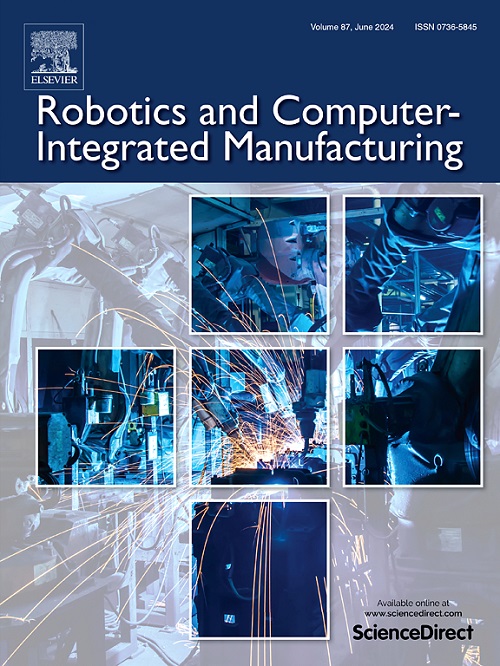基于改进三可逆动态运动原语的示范装配主从双臂学习
IF 11.4
1区 计算机科学
Q1 COMPUTER SCIENCE, INTERDISCIPLINARY APPLICATIONS
引用次数: 0
摘要
对于小间隙的钉孔装配任务,传统的机器人轨迹生成方法严重依赖专家知识,复杂且成本高。相比之下,从演示方法中学习不需要专家知识,并且可以使机器人快速学习和编码装配轨迹。然而,由于装配过程中接触状态丰富,容易干扰和协作约束,双臂演示装配学习仍然是一个具有挑战性的任务。为此,本文首先提出了一种新的动态运动原语方法,该方法具有全局渐近稳定性和可逆性,可以随时切换轨迹生成过程的正反向,以缓解干扰问题。然后,提出了一种基于三位置可逆动态运动基元的统一简洁的机器人位姿同步描述方法。在此基础上,利用三可逆动态运动原语进行双臂协同轨迹学习,并引入从臂力耦合项对其进行修正以达到轨迹顺应性,提出了一种主从双臂演示装配学习算法。最后,以2台UR5机器人为例,进行了3种不同形状的钉孔装配实验,验证了所提方法的有效性。本文章由计算机程序翻译,如有差异,请以英文原文为准。
Master-slave dual-arm learning from demonstration assembly based on modified triple reversible dynamic motion primitives
For the peg-in-hole assembly tasks with small clearance, the traditional robot trajectory generation methods rely heavily on expert knowledge, which is complex and costly. In contrast, learning from demonstration method does not require expert knowledge, and can enable the robots to quickly learn and encode assembly trajectories. However, due to the rich contact states, easy jamming and collaborative constraints during the assembly process, dual arm learning from demonstration assembly remains a challenging task. For the reason, this paper first proposes a new dynamic motion primitives method that has both global asymptotic stability and reversibility, which can switch the forward and reverse directions of the trajectory generation process at any time to alleviate the jamming problem. Then, a uniform and concise robot pose synchronization description approach based on triple position reversible dynamic motion primitives is given. On this basis, through utilizing triple reversible dynamic motion primitives for the dual arm collaborative trajectory learning, and introducing slave-arm force coupling terms to modify them for trajectory compliance, a master-slave dual-arm learning from demonstration assembly algorithm is provided. Finally, based on two UR5 robots, a series of assembly experiments with three different shapes of pegs and holes are carried out, which confirm the effectiveness of the proposed method.
求助全文
通过发布文献求助,成功后即可免费获取论文全文。
去求助
来源期刊
CiteScore
24.10
自引率
13.50%
发文量
160
审稿时长
50 days
期刊介绍:
The journal, Robotics and Computer-Integrated Manufacturing, focuses on sharing research applications that contribute to the development of new or enhanced robotics, manufacturing technologies, and innovative manufacturing strategies that are relevant to industry. Papers that combine theory and experimental validation are preferred, while review papers on current robotics and manufacturing issues are also considered. However, papers on traditional machining processes, modeling and simulation, supply chain management, and resource optimization are generally not within the scope of the journal, as there are more appropriate journals for these topics. Similarly, papers that are overly theoretical or mathematical will be directed to other suitable journals. The journal welcomes original papers in areas such as industrial robotics, human-robot collaboration in manufacturing, cloud-based manufacturing, cyber-physical production systems, big data analytics in manufacturing, smart mechatronics, machine learning, adaptive and sustainable manufacturing, and other fields involving unique manufacturing technologies.

 求助内容:
求助内容: 应助结果提醒方式:
应助结果提醒方式:


